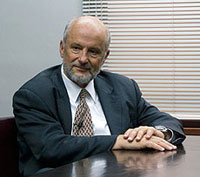| Tuesday, Feb. 15, 2011 |
| Subscribe | Contact Fermilab Today | Archive | Classifieds |
Director's Corner
|
Budgets
We live with a great deal of tension waiting for the resolution of various budgets. February is the month when everything piles up: actions by Congress on the budget for the current fiscal year, FY11; the FY12 budget that the President proposed yesterday to Congress; and preparations for the FY13 budget that DOE has started developing. We'll start with the FY13 budget. We have received guidance from DOE on the scenarios that we should use to propose budgets for the laboratory. The guidance has three scenarios. The middle scenario is essentially flat funding with respect to FY11, in effect the FY10 level since we are in a Continuing Resolution and do not yet know our final budget for FY11. Then there is a lower scenario representing a 5 percent cut from FY10, which is already a very tight situation. Finally there is the scenario that we all dream about but never get, namely one where we propose the budget that we need to carry out our program at full capacity. We will be presenting these three budgets to the Office of High Energy Physics on March 3. Yesterday we saw the President's proposed budget for FY12. This is a budget that is supportive of the Office of Science, with a 9 percent increase over the level of FY10. The major increases are targeted to areas given priority by the administration and that can impact clean energy technologies. Importantly, it maintains the funding for particle physics at the same level as FY10, allowing us to continue development of important programs for our future. At this point we know the amount of funding proposed for the overall particle physics program, but not yet the amount for the laboratory. We assume that it will be roughly flat with respect to FY10, or perhaps slightly lower. Finally there is the very troublesome FY11 budget which is the subject of current deliberation by Congress. This is the budget that the President proposed a year ago and that the Congress has not yet put to bed. There will an open debate this week in the House of Representatives to receive amendments to a year-long Continuing Resolution diminished by a cut of $100 billion in non-defense discretionary spending as proposed by the Committee on Appropriations. This would be a very dramatic cut. There will be much debate in the House and the Senate before any such cut becomes law. Nevertheless, even if the FY11 budget is not yet done, it is important to learn lessons from what has occurred so far, in particular to discern from the Congressional actions where science and innovation stand in the new Congress. Some of the major agencies supporting science such as the NSF and the NIH would receive cuts relative to FY10 at the level of about 5 percent. The proposed cuts for Office of Science are a stunning 20 percent. Because we will be six months into the fiscal year by the time the final FY11 budget is passed, this would amount to a 40 percent cut for the remaining of the year and would be catastrophic not only for our laboratory but for all Office of Science labs. It would stop the operation of user facilities and lead to major layoffs and furloughs. We are working with our representatives to explain the consequences of such cuts on us, on the standing of our nation in science and innovation, and on how we will be viewed by our international partners. Congressional actions so far seem to reflect a misunderstanding of the role of the Office of Science within a generally supportive atmosphere for science and innovation as demonstrated by the bi-partisan support of the America Competes Act. The Office of Science is the main agency for physical science research in our nation and indispensable in the overall framework of scientific research. It provides the main user facilities such as ours at Fermilab, the light sources, neutron sources, electron microscopes, nanoscience centers and large computational facilities that support scientific research and innovation carried out by thousands of people in universities and industries. Without the Office of Science, the scientific enterprise in our country would be crippled. For those of us who understand how science research is done, how the many pieces have to fit together, and how the roles of NSF and DOE in the physical sciences are different but both essential, it is a call to action to explain to the new members of Congress why being supportive of science and innovation must also mean being supportive of the Office of Science. |
